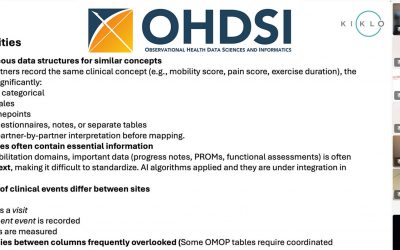- Data Collection: Hospitals collect information from a variety of sources, including electronic health records, medical devices, laboratory systems, billing systems, and patient input. This information encompasses details about the patient’s background, medical history, diagnoses, treatments, medications, lab results, and other related data.
- Data Integration: Hospital data is often present in a variety of systems and formats. Data integration involves combining these diverse sources into one platform or data warehouse, providing a comprehensive view of patient data and enabling analysis from different angles.
- Data Cleaning: Healthcare data in its initial form frequently includes mistakes, lacks completeness, and is susceptible to inaccuracies. The goal of data cleaning is to identify and correct inconsistencies, inaccuracies, missing parts, and abnormalities. This phase is essential for guaranteeing the dependability and quality of the data for future analytical procedures and decision-making needs.
- Data Transformation: Once cleaned, the data may need to be transformed into a standardised format for analysis and reporting. This can involve tasks such as:
- Standardising terminology and coding systems (e.g., ICD-10 for diagnoses, CPT for procedures).
- Normalising units of measurement (e.g., converting between different units of weight or blood pressure).
- Aggregating data to different levels of detail (e.g., summarising patient records by month or year).
- Calculating derived variables or indicators (e.g., computing BMI from height and weight).
- Enriching data with additional information (e.g., socioeconomic data based on patient zip codes).
- Data Analysis: Transformed information is then examined to gain understanding and aid in decision-making. Hospitals utilise a range of analytical methods, including descriptive analytics (summarising past data), predictive analytics (predicting future outcomes), and prescriptive (proposing the best course treatment) analytics, to comprehend patient demographics, pinpoint patterns, predict resource requirements, refine treatment plans, and enhance results.
- Data Visualisation and Reporting: Data analysis results are frequently presented through visual representations like diagrams, charts, dashboards, and reports. Efficient data visualisation enables stakeholders (such as clinicians, administrators, and policymakers) to quickly understand intricate healthcare information and make well-informed choices.
- Data Governance and Security: During the process of transforming data, hospitals are required to adhere to regulations such as HIPAA and safeguard patient privacy. This includes putting in place strong data governance measures, access controls, encryption, and audit trails to protect sensitive information.
The elements mentioned above, along with the process of converting data and leveraging healthcare data to enhance patient results, operational effectiveness, and decision-making within medical facilities are integral to the PREPARE project. The aim of the project is to integrate raw rehabilitation information and use them for analysis and prediction. To date, numerous approaches for transforming data have already been developed. OHDSI, an acronym for Observational Health Data Sciences and Informatics, is a worldwide cooperative community dedicated to enhancing health results through extensive analysis of healthcare data.
Data transformation in hospitals within the context of OHDSI
The PREPARE project leverages the OHDSI open-source framework that provides tools for conducting observational research using real-world healthcare data. Data transformation in hospitals within the context of OHDSI involves several parts:
- Data Transformation
- OMOP Common Data Model (CDM): OHDSI encourages the use of a standardised data model known as the OMOP CDM within participating healthcare facilities. This relational database schema is specifically structured to uniformly capture patient-level healthcare information. Hospitals convert their raw data into the format of OMOP CDM, enabling seamless data exchange, cooperation, and analysis among members of the OHDSI community.
- Data Mapping: Hospitals match their specific data components (e.g., diagnoses, procedures, medications) with the relevant concepts specified in the vocabulary of OMOP CDM. This procedure entails connecting local terminologies like ICD-10 diagnosis codes or CPT procedure codes to standard vocabularies employed in OMOP CDM, such as SNOMED-CT or RxNorm.
- ETL Processes: Hospitals incorporate Extract, Transform and Load processes (ETL processes) to convert their raw data into the OMOP CDM format. This includes Extracting data from different source systems (such as EHRs and billing systems), standardising and harmonising the data through Transformations, and then Loading it into the OMOP CDM database.
- Data Quality Assessment: Hospitals evaluate their revised data to guarantee precision, thoroughness, and uniformity. OHDSI offers resources and recommendations for performing checks on data quality, detecting irregularities in the data, and addressing any problems that could affect the reliability of research results.
- Data Analysis
- Standardised Analytics: Once the data has been converted to the OMOP CDM format, hospitals have access to a range of standardised analysis tools and approaches created by the OHDSI community. These resources facilitate different types of observational studies, such as identifying specific patient groups, characterising population trends, estimating treatment effects, and monitoring safety.
- Collaborative Research: Hospitals share their modified data with large-scale research studies and network studies organised by OHDSI. By combining data from various institutions, researchers are able to perform thorough analyses to produce real-world evidence on the efficiency and safety of healthcare treatments for a wide range of patients.
- Data Governance and Security
- Data Privacy and Security: Hospitals follow strict guidelines for data privacy and security when sharing their processed data with the OHDSI community. This involves anonymising patient information, following data use agreements, and enforcing access controls to safeguard sensitive data.
- Data Quality Assessment: Hospitals evaluate their revised data to guarantee precision, thoroughness, and uniformity. OHDSI offers resources and recommendations for performing checks on data quality, detecting irregularities in the data, and addressing any problems that could affect the reliability of research results.
PREPARE is using the OHDSI framework to standardise healthcare data into the OMOP CDM format, mapping local data to standard terminologies, implementing ETL processes, evaluating data quality, and using collaborative analytics for research and knowledge generation. The OHDSI Framework is a robust platform that supports hospital data transformation and offers a unified approach to managing healthcare information.
Interested in learning more and staying up to date with project insights and developments? Join our mailing list and follow us on X and Linkedin.
Author: Themistoklis Roustanis, KIKLO for PREPARE PROJECT



